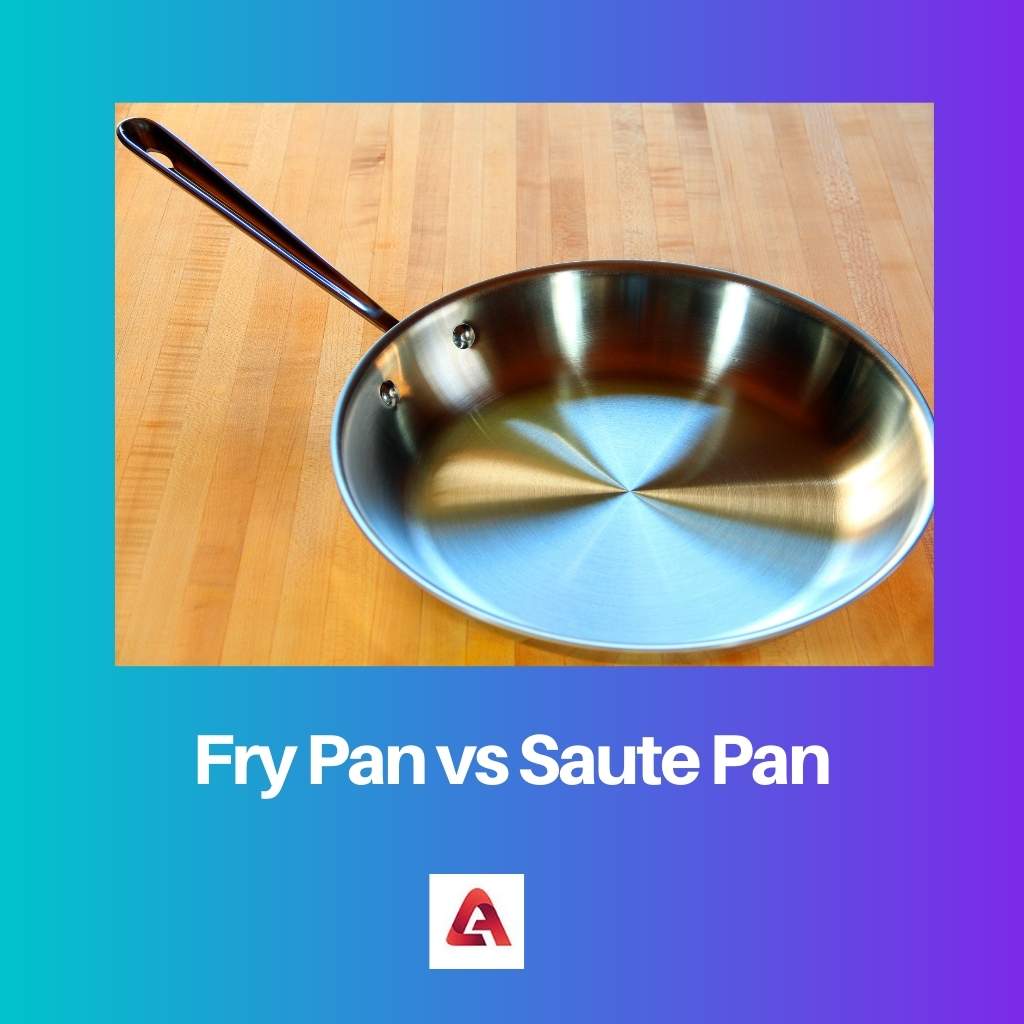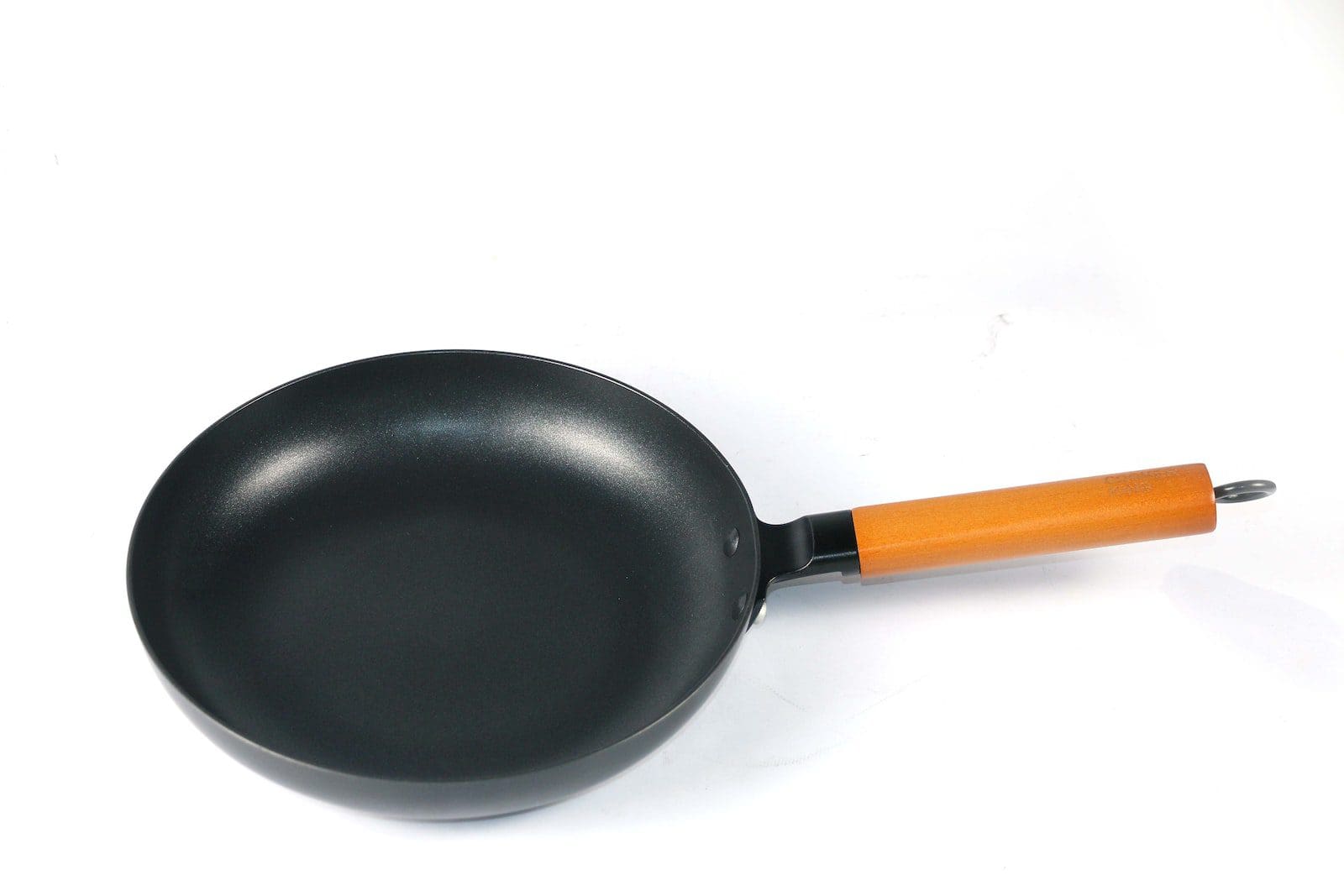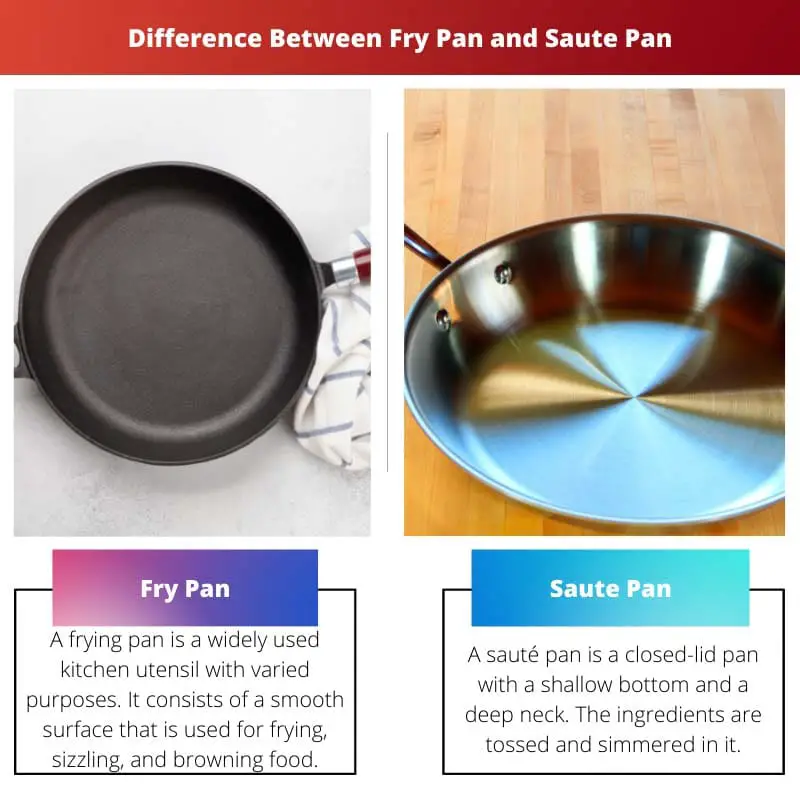It might be tough to distinguish between different types of pans for a newbie cook when purchasing kitchenware.
A well-stocked kitchen includes a wide range of high-quality utensils that may be used for a variety of purposes.
We’re talking about the distinctions between a frypan and a sauté pan, however, there are many different types of pots and pans.
Because of their flexibility and style, these two pans are important in any professional kitchen.
This article highlights the features of both types of pans and compares them head-on to make the readers understand the functions and purposes both pans serve.
Key Takeaways
- Fry pans have a flat bottom and low sides, while sauté pans have a flat bottom and high, sloping sides.
- Fry pans are ideal for cooking foods that need to be flipped, while sauté pans are better for dishes that require stirring or tossing.
- Fry pans are less expensive than sauté pans.
Fry Pan vs Saute Pan
A Fry pan is a compact pan with slopping sides that is used for stir-frying or hot-frying food items at a large heat source and with a small quantity of oil or fat. The sides allow you to flip, stir and rotate items. A saute pan is the combination of a saucepan with a frying pan, with a rounded edge and a covering lid.

A compact pan with sloping sides is known as a fry pan. Stir-frying or hot-frying is a way of cooking in which items are fried quickly in a small quantity of oil or fat, at a considerably large heat source.
The sloped sides make stirring, flipping, and rotating items in the pan simpler, ensuring that everything cooks fast and evenly.
It has a diameter of 20 to 30 cm (8 to 12 in), short edges that flare outwards, a long grip, and no cover. On the other side of certain bigger fry pans, there may be a short grab handle.
Saute pans, on the other hand, combine the functions of a saucepan with a frying pan. It’s a great addition to any kitchen because it can be used for the preparation of a wide range of foods and cooking styles.
A sauté pan is similar in structure and size to a fry pan with some minor differences. A saute pan’s edge flares less, and it may have a covering lid to trap the moisture and for simmering purposes. It is almost always non-stick and coated with Teflon.
Comparison Table
| Parameters of Comparison | Fry Pan | Saute Pan |
|---|---|---|
| Details | A frying pan is a widely used kitchen utensil with varied purposes. It consists of a smooth surface that is used for frying, sizzling, and browning food. | A sauté pan is a closed-lid pan with a shallow bottom and a deep neck. The ingredients are tossed and simmered in it. |
| Purpose and Usage | For frying and sauteing. | For sauteing and light tossing of veggies and other ingredients. |
| Structure and Appearance | With a handlebar and no cover, it has a flat base and somewhat low sides that flare outwards. | The bottom is flat, while the sides are quite low and do not flare. A lid is frequently included. Suitable for storing all of the food in one layer. |
| Also known as | Frying pan and skillet | Sauteing pan and toss plate. |
| Heat Capacity | Can resist high heat sources and conduction is good. | Cannot resist high temperatures due to Teflon coating. |
What is Fry Pan?
A frying pan is a pan with a smooth surface that is used for frying, roasting, and tanning meals. It has a diameter of 8 to 12 inches, with low sides that curve outwards, a long grip, and no cover.
On the other side of certain bigger pans, there may be a tiny grab handle. The bottom is flat, while the sides are quite low and do not flare. A lid is commonly not included. Suitable for storing all of the food in one layer.
The sloping edges of a frying pan allow it to execute a “bounce” movement during cooking. This approach is great for quickly frying a variety of items while ensuring that they cook properly.
Fry pans are seldom used without a cover to allow for simple addition and stirring of contents.
For various characteristics and features, fry pans were originally made of ductile iron, carbon steel, or brass coated with tin.
Copper pans have a strong heat conductivity, which makes them ideal for evenly frying and even sauteing.
However, because copper cookware is extremely reactive with most meals, they are now offered a tin liner that can be changed as it wears out.
Carbon steel pans are utilized because, while not uniformly conducting heat, they retain it effectively, making them ideal for searing meats, veggies and fish too.

What is Saute Pan?
The saute pan gets its name from the Old French terminology “Sauter,” which means “to leap.” This pan is made to prepare a larger amount of food without cluttering it.
A sauté pan is used at medium to high temperature with oil and butter, throwing items back and forth around the air. Food should be golden with a good crust and not mushy when cooked in this pan.
To keep heat and spatter at bay, this pan is used with a cover.
A saute pan consists of a modest depth, square or rounded edges, a strong handle, and a lid.
It is constructed of metal with a thick ground foundation that permits fast temperature swings when the quantity of heat applied to it is raised or diminished.
A standard sauté pan has a capacity of 5 quarts, however, different sizes are also accessible.
Higher, direct pans enable for simpler light frying of larger quantities of food with less oil and also easy flipping and searing of the contents.
A sauté pan is similar in appearance and size to a frying pan, but its edges curve less, and it is equipped with a glass and iron-framed lid for simmering.
It is coated with Teflon or a ‘non-stick’ coating to prevent food from adhering to its surface and to make sauteing and tossing easier.

Main Differences Between Fry Pan and Saute Pan
- A Fry pan is essentially used for frying, whereas a saute pan is used for sauteing and simmering the ingredients.
- A Fry pan is made up of either carbon iron or copper-coated tin, and it doesn’t have a Teflon coating, whereas a sauteing pan is always equipped with a non-stick coating.
- A Fry pan is essentially heavier than a saute pan.
- A Fry pan does not come with a lid, but saute pans require a glass lid for its purpose.
- Fry pans can resist high temperatures and conduct heat quickly and evenly, whereas saute pans only operate in medium to high temperatures. Exposing it to a higher temperature can result in peeling off of the Teflon coating.

- https://www.recipetips.com/glossary-term/t–34640/saute-pan.asp
- https://www.yuppiechef.com/spatula/a-guide-to-frying-pans-choosing-cleaning-care/

I found the historical context of fry pans and sauté pans to be particularly intriguing. This article seamlessly blends culinary knowledge with a touch of cultural insight.
Absolutely, Lisa Wright. The intersection of culinary heritage and practicality in this article is both enlightening and entertaining.
Indeed, Lisa Wright. The incorporation of historical information adds an enriching layer to the already captivating discussion about the pans.
This article provides a comprehensive comparison between fry pans and sauté pans, highlighting their structures, uses and purposes. It’s a great read for anyone looking to expand their knowledge of kitchenware.
I couldn’t agree more. The detailed description and comparison of the two types of pans is extremely informative.
The comparison table in this article succinctly captures the nuances of fry pans and sauté pans, making it an invaluable resource for individuals keen on perfecting their culinary skills.
I couldn’t agree more, Maisie30. The comparison table is a testament to the author’s meticulous approach in presenting a well-structured, informative piece.
Absolutely, Maisie30. The lucid breakdown of the pan characteristics in the comparison table is a commendable aspect of this article.
This article serves as a comprehensive guide to the world of fry pans and sauté pans, unraveling the intricate differences between the two. An exceptional piece of culinary literature.
This article artfully demystifies the world of fry pans and sauté pans, offering readers an enlightening exploration into the subtle yet significant differences between these kitchen essentials.
Absolutely, Mphillips. The article is a testament to the author’s expertise in the culinary domain, shedding light on the nuances of kitchenware with remarkable clarity.
Spot on, Mphillips. The depth of insight provided in this article is truly remarkable, offering both novices and seasoned cooks a wealth of knowledge.
I believe that this article provides a solid understanding of the differences between fry pans and sauté pans, offering clarity for those who are perplexed by the multitude of kitchenware options available.
I couldn’t have said it better, Cox Kimberly. The in-depth analysis of the pans is immensely helpful for those navigating the world of cooking utensils.
Absolutely, Cox Kimberly. The article effectively illustrates the versatility and practicality of both pans, making it an essential read for aspiring chefs.
The distinction between fry pans and sauté pans in this article provides a clear understanding of their specific functions. It’s a must-read for anyone looking to enhance their culinary skills.
Absolutely, Jayden16. This article is nothing short of enlightening, and the comparison table is particularly beneficial for those who are new to cooking.
I find the details about the sloping sides of the fry pan and the shallower sides of the sauté pan particularly intriguing. It’s a fascinating insight into the design differences between the two.
I share the same sentiment, Saunders John. The information about the design variances is both engaging and educational.